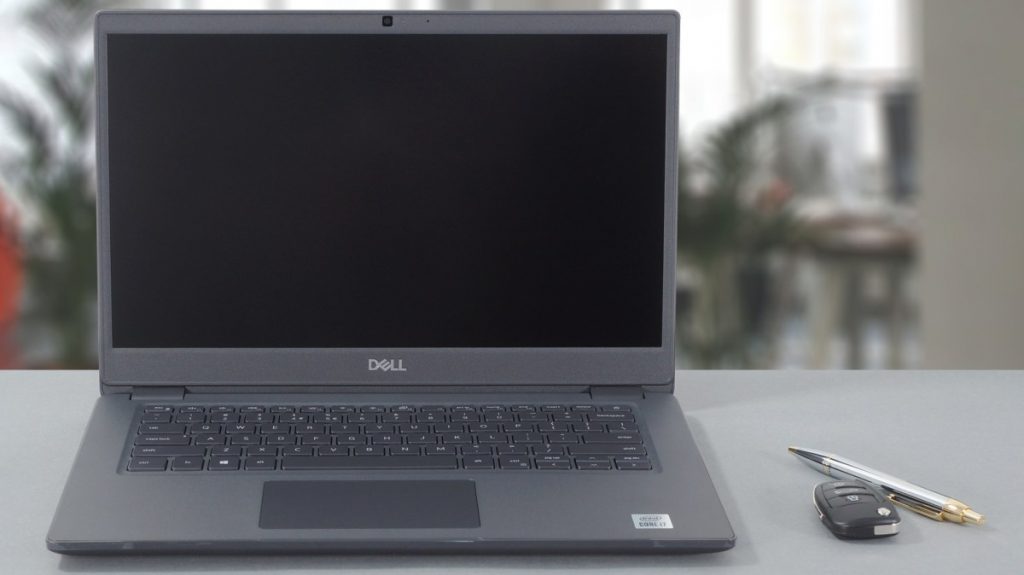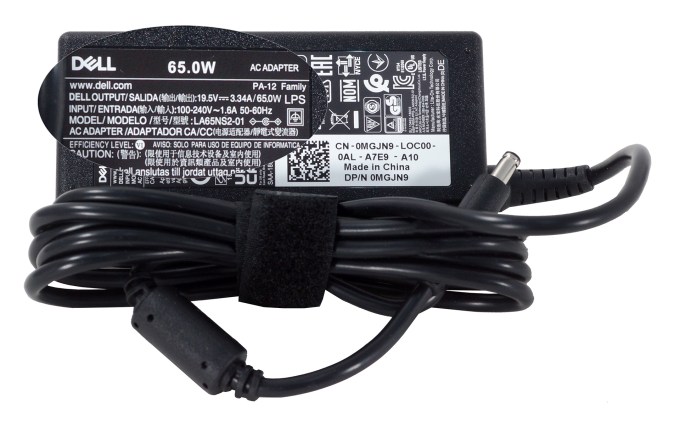
So far, medium to low budget business laptops has been a bit boring. They don’t offer fascinating looks, nor groundbreaking innovations. However, this is a part of their nature. After all, the most important feature they must bring is security.
This applies to the Latitude 14 3410 as well. Although it is entirely made out of plastic, and its design seems dated, we praise its simplicity. Also, not only did we get our unit with preinstalled Windows 10 Pro, but it packs a lot of Dell software, including the Optimizer, security enhancement programs, and more. It’s interesting to see whether the Optimizer is now adequate enough because the last time we had a device, equipped with it, its most useful package was the uninstaller.
What’s in the box?
Inside the package, we found some paper manuals, a 65W power brick, and the laptop, itself.

Design and construction
Generally, the laptop isn’t the thinnest, or the lightest in its class, with its profile standing at 18.3mm, while the weight is 1.61 kg. Its build quality is not bad, but it only uses plastic, which leads to some bends and twists. Its finish is rough and easily scratchable, but the plastic, itself, is thicker than usual, which makes it more resistant to accidents.

Its lid can’t be opened with a single hand. Once opened, the lid shows thick top and bottom bezels, the former housing an HD Webcam. On the bright side, the display has an anti-reflective coating.

Moving to the keyboard, we see a backlit unit with good key travel, and clicky, yet quiet, feedback. The only downside here is the Arrow key placement, and more accurately that of the “Page Up” and “Page Down” keys.
Surprisingly, the keyboard deck is pretty strong, although there is some visible bend when you press harder. As for the touchpad – the unit is accurate and nimble.
When you look at the bottom plate, you’ll see a huge ventilation grill and a couple of speaker cutouts. And on the back – there is an exhaust grill.
Ports
On the left side, you will find the charging plug, an HDMI 1.4 connector, a USB Type-A 3.2 (Gen. 1) port with PowerShare, and a USB Type-C 3.2 (Gen. 1) port. Then, on the right, you can see a wedge lock, an RJ-45 connector, a USB Type-A 3.2 (Gen. 1) port, a USB Type-A 2.0 port, an audio jack, and a MicroSD card slot.

Display quality
Dell Latitude 14 3410 features a Full HD IPS screen, model number LG 4K1TH-140WFA (LGD05F3). Its diagonal is 14″ (35.56 cm), and the resolution – 1920 х 1080. Additionally, the screen ratio is 16:9, the pixel density – 157 ppi, their pitch – 0.161 x 0.161 mm. The screen can be considered Retina when viewed from at least 56 cm (from this distance, the average human eye can’t see the individual pixels).
It has comfortable viewing angles. We have provided images at 45 degrees to evaluate quality.

The maximum measured brightness is 270 nits (cd/m2) in the middle of the screen and 256 nits (cd/m2) average across the surface with a maximum deviation of 10%. The Correlated Color Temperature on a white screen and at maximum brightness is 6480K (average) – matching the 6500K optimum for sRGB.
In the illustration below you can see how the display performs from a uniformity perspective. The illustration below shows how matters are for operational brightness levels (approximately 140 nits) – in this particular case at 52% Brightness (White level = 142 cd/m2, Black level = 0.12 cd/m2).
Values of dE2000 over 4.0 should not occur, and this parameter is one of the first you should check if you intend to use the laptop for color-sensitive work (a maximum tolerance of 2.0 ). The contrast ratio is relatively good – 900:1.
To make sure we are on the same page, we would like to give you a little introduction to the sRGB color gamut and the Adobe RGB. To start, there’s the CIE 1976 Uniform Chromaticity Diagram that represents the visible specter of colors by the human eye, giving you a better perception of the color gamut coverage and the color accuracy.
Inside the black triangle, you will see the standard color gamut (sRGB) that is being used by millions of people on HDTV and on the web. As for the Adobe RGB, this is used in professional cameras, monitors, etc for printing. Basically, colors inside the black triangle are used by everyone and this is the essential part of the color quality and color accuracy of a mainstream notebook.
Still, we’ve included other color spaces like the famous DCI-P3 standard used by movie studios, as well as the digital UHD Rec.2020 standard. Rec.2020, however, is still a thing of the future and it’s difficult for today’s displays to cover that well. We’ve also included the so-called Michael Pointer gamut, or Pointer’s gamut, which represents the colors that naturally occur around us every day.
The yellow dotted line shows Dell Latitude 14 3410’s color gamut coverage.
Its display covers only 50% of the sRGB/ITU-R BT.709 (web/HDTV standard) in CIE1976.
Our “Design and Gaming” profile delivers optimal color temperature (6500K) at 140 cd/m2 luminance and sRGB gamma mode.
We tested the accuracy of the display with 24 commonly used colors like light and dark human skin, blue sky, green grass, orange, etc. You can check out the results at factory condition and also, with the “Design and Gaming” profile.
Below you can compare the scores of Dell Latitude 14 3410 with the default settings (left), and with the “Gaming and Web design” profile (right).


The next figure shows how well the display is able to reproduce really dark parts of an image, which is essential when watching movies or playing games in low ambient light.
The left side of the image represents the display with stock settings, while the right one is with the “Gaming and Web Design” profile activated. On the horizontal axis, you will find the grayscale, and on the vertical axis – the luminance of the display. On the two graphs below you can easily check for yourself how your display handles the darkest nuances but keep in mind that this also depends on the settings of your current display, the calibration, the viewing angle, and the surrounding light conditions.

Response time (Gaming capabilities)
We test the reaction time of the pixels with the usual “black-to-white” and “white-to-black” method from 10% to 90% and vice versa.
We recorded Fall Time + Rise Time = 26 ms.

Health impact – PWM / Blue Light
PWM (Screen flickering)
Pulse-width modulation (PWM) is an easy way to control monitor brightness. When you lower the brightness, the light intensity of the backlight is not lowered, but instead turned off and on by the electronics with a frequency indistinguishable to the human eye. In these light impulses, the light/no-light time ratio varies, while brightness remains unchanged, which is harmful to your eyes. You can read more about that in our dedicated article on PWM.
Dell Latitude 14 3410’s display doesn’t use PWM for brightness adjustment at any level. This makes it comfortable and safe in this aspect, for long periods of use.
Blue light emissions
Installing our Health-Guard profile not only eliminates PWM but also reduces the harmful Blue Light emissions while keeping the colors of the screen perceptually accurate. If you’re not familiar with the Blue light, the TL;DR version is – emissions that negatively affect your eyes, skin, and your whole body. You can find more information about that in our dedicated article on Blue Light.
Conclusions
Dell Latitude 14 3410’s IPS panel has a Full HD resolution, good contrast ratio, comfortable viewing angles, and a non-flickering backlight. Unsurprisingly, as a budget panel, it offers only 50% of sRGB coverage and non-flattering color accuracy.

